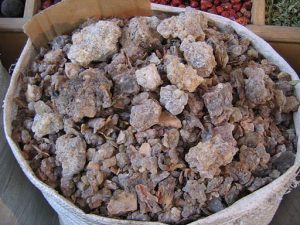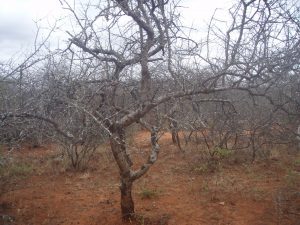
By Daisy Ouya, originally published at ICRAF’s Agroforestry World Blog
There’s one more reason to be jolly this season: the frankincense tree—source of one of the precious gifts of the Magi in the Christmas story—is being called “a suitable tree species for use in dryland restoration under a changing climate.”
Based on studies on frankincense trees (Bosweillia neglecta) from southern Ethiopia that form part of the CGIAR Research Program on Forests, Trees and Agroforestry, World Agroforestry Centre (ICRAF) and partner researchers are calling for this tree’s expanded application in the restoration of drylands in the Horn of Africa.
In this region, covering Ethiopia, Eritrea, Djibouti, Somalia, and parts of northern Kenya, frankincense is tapped from Bosweillia and several other dryland trees found naturally in dry tropical forests and woodlands. When injured, the bark exudes a fragrant watery sap, which is collected and left to harden into the frankincense resin. Bosweillia neglecta tree produces a particular, earthy frankincense known as ‘Borena type’.
An important commodity, frankincense is used in pharmacology, as a flavouring, in cosmetics and in perfumery, and is traded locally and internationally. The incense is used in many religious and cultural ceremonies around the world; indeed, no Ethiopian coffee ceremony is complete without the sweet, heady aroma frankincense releases when heated over hot coals.
Although Bosweillia species are so important for the environment and society in the Horn of Africa, their habitats—dry forests and woodlands—are under threat of decimation from a complex of human activities, unsustainable exploitation, and climate change.
Using dendrochronology—the science of analyzing and dating tree growth rings—Mulugeta Mokria sought to unravel Bosweillia neglecta’s response to wet and dry conditions over several decades past. The study was part of his MSc degree at Wageningen University, with research conducted in his native Ethiopia’s Arero district, at the ICRAF dendrochronology laboratory, and at the dendrochronology lab of Wondo Genet College of Forestry and Natural Resources, Ethiopia.
Under the joint supervision and collaboration of scientists from Wageningen university, ICRAF and Ethiopia, Mulugeta focused on the frankincense tree’s responses to water availability. The research brought together visual and microscopic examination of tree rings and wood vessels; meteorological data (from a weather station close to the studied trees); and leaf phenology data (obtained from NASA satellites). Taken together, the data were used to reconstruct the behaviour of the frankincense tree during the area’s two rainy seasons per year, the dry seasons, as well as the periodic droughts that prevailed over the 30 years between 1982 and 2012.

The research revealed how the tree changed its behavior and anatomy to avoid drought-induced damage:
“As the rainy seasons ended, the tree shed its leaves, and formed smaller stem vessels. This was in contrast with the beginning of the two rainy seasons, when the tree had full leaf cover and larger stem vessels in its growth ring,” said Mulugeta.
These strategies— dropping leaves and reducing vessel size—helped the plant minimize water loss and cope with drought.
“What is interesting about this species is that it sheds its leaves twice a year and forms two rings in a year in concurrence with the biannual rainfall pattern. As a result, Bosweillia has been able to survive and even expand across the water-limited dryland conditions of southeastern Ethiopia,” said Aster Gebrekirstos, head of ICRAF’s Dendrochronology Laboratory.
“Based on these findings, as well as on ecological, economic and cultural considerations, we conclude that the tree is highly suited for restoration of woodlands in the Horn of Africa.”
Fire ban
Dendrochonological dating of the trees studied showed they were 22 years old on average (range 16- 28 years).
From this, Mulugeta and co-researchers concluded that the expansion of B. neglecta was greatly helped by a ban on bush burning imposed between 1968 and 1976 in the southern Ethiopian rangelands. The moratorium disallowed pastoralists in the region from using fire to control bush encroachment into their grazing lands.
The ban “created favourable environmental conditions for B. neglecta to successfully colonize the study area,” explains Gebrekirstos.

“Using dendrochronology, we are able to look back on the impacts of climate change on plant production, ecosystem services and vegetation dynamics, and use this knowledge to recommend suitable species for future climates. In this way we can contribute meaningfully to national and global efforts to restore degraded landscapes.”
Livelihoods
Ethiopia is one of the major suppliers of frankincense to the world market. A CIFOR study reported that in the 2007/2008 Ethiopian fiscal year, the country exported 3834 tons of gums and resins, earning US$ 5.2 million (Leminih and Kassa 2011).
As such, promoting the frankincense tree for restoration would meet not only ecological but also livelihood-improvement targets for people in the water-stressed zones of the Horn of Africa; In certain frankincense-producing rural communities, the resin brings in up to a third of household income.
Policy incentives could be used to promote farmer-managed natural regeneration of the trees and to reduce the degradation of dryland forests and woodlands where Boswellia neglecta, Boswellia papyrifera, and other frankincense-producing trees occur naturally.
Other priorities would include developing more sustainable tapping methods for the resin, improving post-harvest handling and marketing, and conducting research aimed at domesticating the tree, so it can be grown on farms as an agroforestry species.
With attention to sustainability, the frankincense tree will continue to give the gift of its precious resin, but also the important environmental services that dryland trees provide.
—–
Read journal article:
“The frankincense tree Boswellia neglecta reveals high potential for restoration of woodlands in the Horn of Africa”. By Mulugeta Mokria, Motuma Tolera, Frank J. Sterck, Aster Gebrekirstos, Frans Bongers, Mathieu Decuyper, and Ute Sass-Klaassen. Forest Ecology and Management 385 (2017) 16–24.
(http://dx.doi.org/10.1016/j.foreco.2016.11.020)
Related publication:
Management guide for sustainable production of frankincense: A manual for extension workers and companies managing dry forests for resin production and marketing. By Mulugeta Lemenih and Habtemariam Kassa












